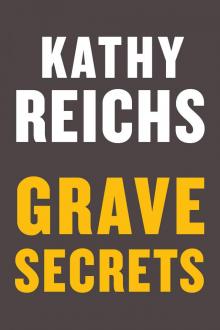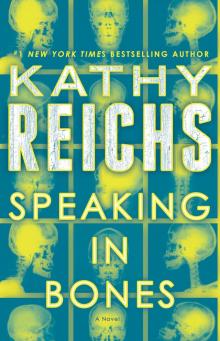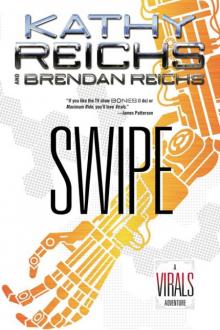- Home
- Kathy Reichs
Spider Bones: A Novel Page 7
Spider Bones: A Novel Read online
Page 7
I conveyed Danny Tandler’s condolences. She slurped.
I launched my pitch. Snorkeling. Diving. Maybe a surfing lesson or two.
Katy listened, eyes on steam rising from her mug.
Interpreting shrugless silence as interest, I continued. Diamond Head. Waikiki. Lanikai Beach.
“So. What do you think, sweetie? Aloha?” I pantomimed a little hula.
“I guess.”
Not exactly “Yippee!” But she was willing to go.
By noon, thanks to Charlie Hunt’s intervention, the public defender’s office had granted a “compassionate leave” for its very junior first-year researcher. Two weeks. Unpaid.
Fair enough.
After a lunch of tomato soup and tuna sandwiches, Katy and I dug out and organized scuba and snorkeling gear. At least I did. She mostly watched.
I made calls when Katy went home to pack. LaManche had no objection to my two-week absence from the LSJML in Montreal, provided I was reachable by phone. Pete agreed to take Birdie. My neighbor agreed to look after the town house. Tim Larabee, the Mecklenburg County medical examiner, asked that prior to my departure I examine a skull found off Sam Furr Road just north of Charlotte. I promised to do the analysis the following day.
Danny rang around six with flight information. Convinced of the righteousness of his plan, he’d gone ahead and booked a reservation for Katy.
Danny said he’d meet our plane, warned teasingly of a surprise. No amount of cajoling could wangle further information from him. Slightly uneasy, I disconnected.
Thursday night, after wrapping up with the Sam Furr skull, I treated Charlie Hunt to dinner. Partly because I missed him. Partly to thank him for scoring Katy her unearned vacation.
We met at Barrington’s, a tiny bistro buried in a southeast Charlotte retail complex. Unlikely location. Pricey tab. Kick-ass food.
I had the tagliatelle. Charlie had the grouper. For dessert, we shared an order of bread pudding with white chocolate ice cream.
Afterward, leaning on my Mazda, I said mahalo to Charlie in a very big way. His response indicated eagerness to continue the thank-you at his place.
I was tempted. Very tempted.
But not yet.
To Charlie’s dismay, we both went home solo.
Getting to Hawaii from North Carolina is easier now than back in the nineties when I consulted to the CIL. But the trip still takes half your life.
I rose at dawn on Friday and called Katy. She was up, but sounded groggy. Said she couldn’t sleep and had spent all of Thursday and into the wee hours writing about Coop’s death.
My daughter had begun blogging the previous winter. I’d visited her site, ChickWithThoughts.blogpost.com, and been surprised at the eloquence of her posts. And at the serious nature of the subject matter. Topics ranged from presidential politics, to ecoterrorism, to global economics. I’d been astounded at the number of people who read and participated in the discussions.
Flying US Airways from Charlotte via Phoenix, we arrived in Honolulu at two thirty in the afternoon. One gains five hours traveling west, so the outbound leg seemed deceptively painless. But I knew from experience. The return would lay me low.
Though I hadn’t been involved in the official transfer, I was aware of the young man riding below us in the cargo bay. Throughout the journey my thoughts had repeatedly drifted to him. Who was he? What was his story? How had he ended up in Spider Lowery’s grave?
Katy slept through most of the flight. I tried writing reports, gave up. I’m lousy at working on planes. I blame it on altitude. It’s really just lack of discipline.
The movie offerings were approved by censors for both sailors on shore leave and four-year-old Baptists, so I read, alternating between a Hawaiian travel book and a Stephen King novel.
During one of her brief waking periods, I explained the JPAC issue to Katy. No details. The last thing she needed was a reminder of the tragic cost of war. But Katy would be on her own while I was working at the CIL. She’d be curious about where I was and why.
Katy listened without interrupting, a response I found unsettling. Normally my daughter would have posed a thousand questions and offered an equal number of opinions. I understood her listlessness. Though Katy kept it to herself, I’d overheard her rephoning the Coopertons before leaving my house on Thursday. Her side of the conversation indicated another rebuff.
As promised, Danny was waiting in baggage claim, cart at the ready. Upon spotting us, he beamed like a kid who’d just downed a Snickers.
Hugs all around.
While Danny and I collected the luggage, Katy went in search of a john. Danny took the opportunity to query my daughter’s state of mind. I waggled a hand. So-so.
I asked about the remains from Lumberton. He said that Silas Sugarman had delivered the transport container to the Charlotte airport and that it was listed on the manifest of our flight.
I knew the drill. The transport container would be off-loaded and taken to the cargo area, where it would be met by personnel from Borthwick, a local Oahu mortuary. With paperwork completed, the coffin would travel by hearse to Hickam and enter the CIL through a rear door. An accession number would be assigned, and the remains would await processing.
The Avis line moved at the pace of sludge. When I reached the counter, the agent could find no trace of my reservation. After much sighing and head-shaking, a car was finally located, a red Chevrolet Cobalt about the size of my purse.
Danny helped load our suitcases. Then, refusing to divulge any clue concerning our hotel, he insisted I follow his Honda.
In the past, when consulting to the CIL, I was always billeted in a moderately priced hotel on Waikiki Beach. That meant traveling roughly southeast into town.
Danny’s route surprised me. He looped north on the H-1, then cut east on the H-3 toward Kaneohe.
We’d barely cleared the airport when Katy slumped against the window and fell asleep. My little navigator. It would be up to me to keep Danny in sight. Challenging, since the guy had a foot twice the atomic weight of lead.
Twenty minutes out, Danny merged onto Highway 630, Mokapu Boulevard, then turned south on Kalaheo. Eventually we passed Kailua Beach Park.
As my internal GPS engaged, I felt a buzz of excitement. Danny knew that my favorite stretch of Oahu sand was Lanikai Beach. Lanikai lies just south of Kailua. Was that where Danny was going? Was that his surprise?
Forget it, a pessimist neuron scoffed. You’re traveling on the military dime.
Anything’s possible, an optimist fired back.
Once over the bridge at Kailua, it was like driving in Charlotte. At every little jog, the street name changed. Lihiwai. Kawailoa. Alala. Mokulua.
Hawaiian. You gotta love it.
Finally, Danny pulled into an opening barely visible between towering hedges. I followed.
The driveway led through an expanse of lawn to a two-story stucco home with lanais bordering three sides. Beyond the house I could see more grass, white sand, and the glittering turquoise of Kailua Bay.
Danny pulled to a stop, got out, and walked toward my car. I lowered my window.
“Home sweet home.” He swept a theatrical arm.
“We’re staying here?” I admit. It was almost a squeal.
A grin split Danny’s face from ear to ear.
Katy sat up and squinted through the windshield.
“How did you pull this off?” I asked.
“Danny has his ways.” Tapping one temple.
I curled my fingers in a “give me more” gesture.
“The place belongs to a retired colonel. He’s gone a month, visiting his kids on the mainland, and feels more secure with someone in residence.”
Katy climbed from the car and walked toward the house.
“Shall we see if accommodations are up to madam’s high standards?”
Ignoring the faux-British accent, I got out and followed Danny to the front door.
Things were definitely up to standar
d. A standard about which, given my profession, I had only heard rumors.
The decor was Hawaiian plantation meets modern tech. Arched windows and doorways. Carved woodwork. Luxurious greenery. Stone and Brazilian cherry floors.
The dining and living areas had vaulted wood ceilings and sliding glass doors leading to lanais overlooking a pool. Beyond the pool, thirty yards of lawn swept down to a row of coconut palms and the beach.
The kitchen had every appliance patented in the new millennium and enough stainless steel to outfit an OR. A bedroom and bath, a powder room, a small gym, and an office rounded out the first floor.
Each of the three upstairs suites had a bath with walk-in shower, Jacuzzi, and an acre of marble. King beds. Flat-screen TVs. Ceiling fans. Heart-stopping floor-to-ceiling ocean views.
As Danny gave the tour, Katy trailed mutely behind.
“Which room did you like?” I queried when we’d finished.
“The green one’s OK.”
“It’s yours,” I said.
“Now what?” I asked when Katy had gone to the car for her luggage.
Danny looked at his watch.
“It’s Friday, now almost five. The lab will be emptier than a politician’s heart.”
I couldn’t help smiling at Danny’s metaphor.
“I’ve unearthed some info on Lowery. It’s not much. Forty-plus years is a long time. How about I brief you, then you and Katy relax over the weekend? Monday morning, we’ll meet at the CIL and start the analysis.”
While I was disappointed at the two-day delay, Danny was right. It was almost 10 p.m. East Coast time and I’d been up since 5 a.m. I’d slept little on the plane and was probably beyond my capacity for critical thought. More important, I didn’t want to leave Katy alone right away.
“Sounds like a plan,” I said.
Danny offered to carry my things from the car. I told him I could handle my own suitcase and laptop. He proceeded to get them anyway.
While Danny collected my belongings, I checked the refrigerator. It was packed. Soft drinks. Juice. Cheese. Yogurt. Hummus. Fruit and veggies. Bagels and cream cheese. Trays of prepackaged sushi.
I opened a few cupboards. Same deal.
The generosity was so Danny. Time and again, when I’d been down, he’d sent a silly gift to make me smile. When I’d been buoyant, pleased over some small victory or accomplishment, he’d sent a silly gift to enhance my happiness.
When Danny returned, I thanked him and offered to pay for the groceries. He asked for a brew but declined the dinero.
We argued. Danny finally provided a figure. Knowing it was low, I doubled the amount and wrote a check. Then we both settled into lounge chairs on the lanai.
“Spider’s story isn’t going to please his old man.”
Danny downed a slug of Corona and began.
“In December of nineteen sixty-seven, while stationed in Vietnam, Private John ‘Spider’ Lowery took unauthorized absence from his unit.”
“He just split?”
“Apparently. Six weeks later he was arrested by MPs at the home of a Vietnamese hooker on the outskirts of Saigon.”
“They were ranching?” I used the Vietnam-era term for shacking up.
Danny nodded. “Long story short, Lowery landed in the Long Binh jail, a military stockade on the road between Bien Hoa and Saigon. Eventually he was offered early release from the slammer if he rejoined his unit and went back to duty.”
“Was that standard practice?”
Another nod. “The war was in overdrive and the military needed as many bodies in action as possible, so if the offense was only UA the military would deal.”
1968. The Tet offensive. The Battle of Hue.
I’d been a kid at the time, but association with JPAC had familiarized me with details.
In January of 1968, hoping to spark a national uprising, the North Vietnamese Army, or NVA, and the National Front for the Liberation of South Vietnam, or Vietcong, broke the traditional Lunar New Year truce and launched the Tet offensive. Over 100 cities were attacked. So were Westmoreland’s headquarters and the U.S. embassy in Saigon.
During this urban offensive, the combined Vietcong and NVA troops captured Hue. The marines then counterattacked and took the former capital back, inch by bloody inch.
“Spider was released from Long Binh on January 23, 1968, and boarded a Huey to be returned to his unit,” Danny continued. “The passenger manifest listed four crew and Private Lowery. Shortly after takeoff, the Huey crashed and burned with the loss of all on board.
“Three crew members were recovered and identified the next day. Two warrant officers who were the pilot and copilot, and a sergeant who was the crew chief. A fourth badly burned body was discovered near the crash scene several days later. The body was wearing army fatigues but no insignia.”
“Wasn’t that odd?”
“Not given the fact that Lowery was fresh out of jail.” Danny took another pull on his beer. “The burned body was sent to the Tan Son Nhut mortuary, where forensic analysis showed that the victim fit Lowery’s profile, including age, sex, race, and height.”
“What about the fourth crew member?”
Danny shook his head. “A Spec 2 maintenance guy. They ruled him out. Not sure why.”
“Were his remains ever found?”
“I’ll have to ask.” More beer. “Following identification and processing, Lowery’s remains were shipped from Tan Son Nhut to Lumberton, North Carolina, for burial. End of story.”
“Apparently not,” I said.
“Apparently not.” Danny set down his empty bottle and rose. “You and Katy have a nice weekend.”
Despite Katy’s anguish, we did.
KATY WAS STILL SLEEPING WHEN I SET OUT MONDAY MORNING. Her day would be a repeat of both Saturday and Sunday. Reading by the ocean, later by the pool. A bit of snorkeling. A run on the beach. A long nap.
Hawaii hugs the equator, so island weather varies little. Sunny, highs in the eighties, maybe a blink-of-the-eye afternoon shower. In a word, perfect.
That descriptor does not apply to Honolulu’s rush-hour traffic.
Creep and lurch. Creep and lurch.
In addition to JPAC, Hickam Air Force Base is home to the Fifteenth Airlift Wing and sixty-seven partner units, including Pacific Air Forces Headquarters and the Hawaii Air National Guard. As with most military compounds, outsiders don’t just stroll in.
Queuing at the gate took a full ten minutes. When I finally reached the front of the line, an exceedingly spit-and-polished young man saluted me into an office manned by orange-vested security personnel.
Danny had left credentials. Once the car registration and safety-check paperwork were scanned, I was quickly cleared.
After skirting the military airport, I looped the traffic circle and drove past the air wing headquarters. The building’s bullet holes, still visible from the December 7, 1941, attack that pushed the U.S. into World War II, are pointed out to every first-time visitor to the base.
Eventually I made a right, wound past aircraft hangars, turned left, and pulled into a small parking lot. Building 45. The military coins such poetic names.
I dialed Danny on my mobile. He answered and said he’d be right out.
While waiting, I thought about the charge of those working inside the nondescript brown building. About the raison d’être of JPAC.
From 1959 until 1975, North Vietnam, supported by its Communist allies in the south, battled the government and armed forces of South Vietnam, supported by the United States and other members of SEATO, the Southeast Asia Treaty Organization. At its peak, the war kicked the crap out of Vietnam, Laos, and Cambodia.
Here’s how the conflict played out.
While the lightly armed Vietcong fought a hit-and-run guerrilla war, the NVA employed more conventional tactics, often committing large-sized units to battle. The U.S. relied on its usual trifecta of ground forces, heavy artillery, and gonzo airpower.
The human to
ll was enormous: 3 to 4 million Vietnamese from both sides; 1.5 to 2 million Laotians and Cambodians; 58,159 Americans.
Eighteen hundred of those Americans never came home and were not accounted for.
Thus the CIL, later JPAC.
Here come the acronyms.
The Central Identification Laboratory Thailand, CIL-THAI for short, was founded in 1973 to locate American military personnel missing in Southeast Asia. Three years later the lab was moved to Honolulu, its mission expanded. The Central Identification Laboratory Hawaii, CILHI, would henceforth search for, recover, and identify Americans missing from all previous conflicts. Today, in addition to Vietnam, that total includes 120 soldiers from the Cold War, 8,100 from the Korean War, and 78,000 from World War II.
Fast-forward almost two decades from the founding of CILHI.
In 1992, the Joint Task Force–Full Accounting, JTF-FA, was established to ensure the fullest possible resolution of questions surrounding Americans missing in Southeast Asia. Another decade and the Department of Defense, DOD, decided that accounting efforts would best be served by a single entity. Thus, in 2003, the two organizations were merged to form the Joint POW/MIA Accounting Command, JPAC.
As with its predecessor, JPAC’s mission is to find American war dead and bring them home. Core operations involve the pursuit of leads, the recovery of remains and artifacts, and the identification of individual soldiers, sailors, airmen, and marines.
Every investigation begins with paper. JPAC historians and analysts gather correspondence, maps, photographs, unit histories, and medical and personnel records. JPAC’s research and intelligence section backgrounds history.
Most investigations also utilize sources outside JPAC, including the national archives and record depositories maintained by the U.S. and foreign governments. Veterans, civilian historians, private citizens, families of missing Americans, and amateur researchers also routinely provide information.
Ultimately, JPAC experts combine everything into a “loss incident case file.” At any given time, approximately 700 active files are under investigation at the CIL.
Danny emerged wearing a pink aloha shirt and baggy brown pants. Behind the thick lenses, his eyes blinked in the sunlight.

 Two Nights
Two Nights The Bone Collection: Four Novellas
The Bone Collection: Four Novellas Fatal Voyage
Fatal Voyage 206 Bones
206 Bones Bones to Ashes
Bones to Ashes Terminal
Terminal Monday Mourning
Monday Mourning Flash and Bones
Flash and Bones Cross Bones
Cross Bones Devil Bones
Devil Bones Break No Bones
Break No Bones Swamp Bones
Swamp Bones Déjà Dead
Déjà Dead Shock
Shock Spider Bones
Spider Bones Death Du Jour
Death Du Jour Grave Secrets
Grave Secrets Trace Evidence: A Virals Short Story Collection
Trace Evidence: A Virals Short Story Collection Bones on Ice
Bones on Ice The Bone Code
The Bone Code Bones in Her Pocket
Bones in Her Pocket Seizure:
Seizure: Speaking in Bones
Speaking in Bones Deadly Decisions
Deadly Decisions Spike
Spike Bones Never Lie
Bones Never Lie Bones of the Lost
Bones of the Lost Virals 03.5 - Swipe
Virals 03.5 - Swipe Exposure
Exposure A Conspiracy of Bones
A Conspiracy of Bones Shift (tory brennan)
Shift (tory brennan) Bones of the Lost: A Temperance Brennan Novel tb-16
Bones of the Lost: A Temperance Brennan Novel tb-16 Virals tb-1
Virals tb-1 Bones Are Forever tb-15
Bones Are Forever tb-15 Code tb-3
Code tb-3 Seizure tb-2
Seizure tb-2 Deadly Descisions
Deadly Descisions Spider Bones: A Novel
Spider Bones: A Novel